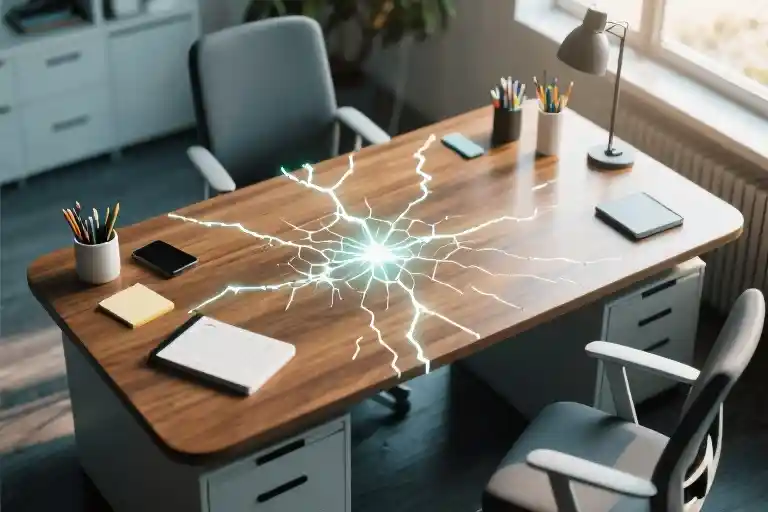Alex’s alarm goes off at 6:15 AM like every other weekday. Before his feet even touch the floor, his hand instinctively reaches for the phone – three urgent emails from the overseas team, two Slack pings about rescheduled meetings, and a calendar notification for the 8:30 AM cross-departmental sync. By the time he finishes brushing his teeth, he’s already made seven micro-decisions about how to handle these incoming demands. His shoulders feel heavy before breakfast.
This isn’t laziness. In fact, Alex uses the same premium productivity app as Fortune 500 CEOs, color-codes his calendar religiously, and never misses his weekly planning session. Yet by 11 AM, his brain feels like an overworked engine sputtering on low-grade fuel. The puzzling part? His workload hasn’t increased – if anything, he’s gotten better at time management over the years.
Here’s what no planner will tell you: Your energy isn’t leaking from the big, obvious stressors. It’s seeping out through hairline cracks in your daily routine – those small, persistent drains you’ve learned to tolerate because everyone else seems to handle them just fine. That background app constantly checking for new messages? The mental gymnastics of deciding what to prioritize when everything’s marked ‘URGENT’? The nagging guilt about that half-finished side project? These aren’t just minor inconveniences. They’re silent energy thieves running a 24/7 withdrawal operation on your mental reserves.
We’ve been conditioned to think fatigue stems from not doing enough – not sleeping enough, not exercising enough, not planning meticulously enough. So we double down on tracking and optimizing, unaware that we’re pouring water into a bucket riddled with invisible holes. The real breakthrough doesn’t come from adding another productivity tool, but from finally noticing where your power has been escaping all along.
The Hidden Mechanics of Energy Leaks
That vague sense of exhaustion clinging to you by mid-afternoon isn’t a personal failure—it’s physics. Your mental energy operates like a vintage pipe system: small, unnoticed cracks create cumulative drainage until the pressure drops to a trickle. Three characteristics make these leaks particularly insidious.
The Camouflage Effect
Your brain has an excellent survival mechanism—it normalizes persistent stressors. That colleague who always leaves you subtly drained after interactions, the 47 browser tabs you ‘just keep open in case,’ the background anxiety of an unanswered Slack message. These aren’t dramatic energy crises, just slow drips wearing down your reservoir. Like ambient noise you stop consciously hearing, their very familiarity makes them dangerous.
Neuroscience reveals why we overlook these leaks: the basal ganglia automates repetitive experiences to conserve cognitive resources. What initially triggered stress responses (say, your boss’s passive-aggressive emails) eventually gets filed under ‘normal work stuff.’ The alarm silences itself while the energy toll continues.
The Compound Interest Problem
A single 10-minute meeting where you pretend to care about printer supplies seems harmless. But multiply that by three similar interactions daily, add the mental reload time after each context switch, and you’ve lost 90 minutes of prime cognitive capacity before lunch. Energy leaks follow the same math as financial debt—small amounts accrue devastating interest when left unaddressed.
Consider the cognitive cost of micro-decisions:
- ‘Should I check email now or later?’ (3 mental calories)
- ‘Do I have time for this coffee chat?’ (5 calories)
- ‘What excuse can I give to skip this call?’ (8 calories)
These trivial choices use the same prefrontal cortex resources as important work. Like a phone running multiple background apps, your battery drains even during ‘idle’ time.
The Boiling Frog Syndrome
The most perilous leaks are those you’ve stopped feeling entirely. Human adaptation works against us here—just as eyes adjust to dim light, we acclimate to chronic energy drains until they become invisible. That perpetually messy desk? The toxic ‘low-key emergency’ culture at your office? The 20 minutes daily spent scrolling ‘just to unwind’ that actually leaves you more frazzled? All now register as baseline normal.
This explains why people often realize their energy leaks only in retrospect—after changing jobs, ending a relationship, or taking a long vacation. The sudden contrast reveals what daily acclimation had hidden. Like removing glasses you forgot you were wearing, the world suddenly seems sharper, colors more vivid.
Energy leaks share key traits with carbon monoxide—odorless, invisible, and deadly over time. The first step in sealing them isn’t willpower, but awareness.
The Energy Audit: Diagnosing Six High-Frequency Leak Scenarios
Most of us walk through our days like a smartphone with 47 apps running in the background. The screen looks clean, but the battery drains at twice the normal rate. Here’s how to identify what’s secretly consuming your mental RAM:
Zombie Tasks: The Undead in Your To-Do List
These are the tasks that shamble through your planner month after month – “learn Spanish,” “reorganize garage,” “update LinkedIn.” They’re not urgent enough to prioritize, not rewarding enough to excite you, yet they occupy valuable mental real estate. Each unchecked box becomes a tiny guilt generator, leaking 2-3% energy every time your eyes glance over it.
Recovery tactic: Conduct a weekly “exorcism” – either schedule it with military precision in the next 72 hours or delete it permanently. If you haven’t done it in six months, you won’t.
Emotional IOUs: The Hidden Cost of People-Pleasing
That colleague who always “quickly picks your brain,” the friend who treats you like a free therapist, the family group chat that demands daily engagement – these relationships operate on an energy credit system where you’re always the creditor. Unlike healthy exchanges, emotional labor debts compound interest silently.
Leak test: After any interaction, notice if you feel energized or depleted. Track patterns over two weeks. Relationships shouldn’t consistently leave you needing a nap.
Decision Quicksand: Where Small Choices Swallow Hours
From “which yogurt to buy” to “which Netflix show to watch,” modern life bombards us with trivial choices that exhaust the same neural pathways used for important decisions. Stanford research shows decision fatigue reduces willpower like blood sugar drops – by afternoon, you’re mentally diabetic.
Firewall method: Create personal defaults (work uniforms, meal routines) to conserve decision juice. Implement a “no choices before coffee” rule. Batch trivial decisions into weekly 15-minute power sessions.
Digital Distractions: The 21st Century Energy Siphon
Your phone isn’t a tool – it’s a slot machine designed to exploit your dopamine system. Each notification pulls you into micro-workflows: see text → remember to buy milk → notice grocery app → see Amazon ad → fall into review rabbit hole. This context-switching burns 20% more cognitive energy than focused work.
Energy shield: Turn all notifications grayscale. Designate specific “digital admin” times. Install distraction-blocking apps that force single-tasking. Your brain wasn’t built for this much stimuli.
Environmental Toxins: When Your Space Sabotages You
That flickering office light, the uncomfortable chair you “just deal with,” the clutter in your peripheral vision – these physical irritants trigger low-grade stress responses. Like sleeping next to a dripping faucet, the cumulative effect drains reserves you don’t realize you’re spending.
Detox scan: Walk through your workspace noting anything causing subtle tension – adjust lighting, remove visual noise, optimize ergonomics. Your surroundings should feel like a deep breath, not background static.
Self-Consumption: The Perfectionism Paradox
Over-researching, over-preparing, over-editing – these aren’t diligence, they’re fear in work clothes. The brain can’t distinguish between “making it perfect” and “avoiding judgment,” so it burns energy like a Vegas neon sign. Finished is always better than perfect because finished actually exists.
Antidote: Set artificial constraints (“I’ll spend only 30 minutes on this presentation”). Implement the “good enough” rule. Notice how often extra effort yields diminishing returns.
This isn’t about working harder at energy management – it’s about working smarter at energy conservation. Like fixing leaks in an old house, the repairs seem small but the savings compound dramatically. Tomorrow we’ll explore how to patch these cracks, but for today, just notice: where does your energy vanish without explanation?
The Energy Leak Repair Toolkit
When your phone battery drains unexpectedly, you don’t just buy a better charger – you check which apps are running in the background. The same principle applies to your mental energy. Here’s how to patch those invisible leaks at three different levels of intervention.
Emergency Fixes (5-Minute Solutions)
These are your mental band-aids for when you’re actively hemorrhaging energy:
- The Headphones Hack
Slip on noise-canceling headphones without playing music. This creates an instant psychological barrier against interruptions, reducing the cognitive load of potential social interactions. Studies show even the physical presence of headphones reduces unwanted interruptions by 43%. - Brain Dump Method
Grab any writing surface when overwhelmed and complete this sentence: “What’s actually draining me right now is…” Keep writing without stopping for 3 minutes. The act of externalizing swirling thoughts frees up working memory capacity immediately. - The 20-Second Rule
For recurring energy leaks (like checking emails compulsively), add a 20-second friction point. Move the email app icon to a folder within a folder. That tiny delay disrupts autopilot behavior long enough for your prefrontal cortex to regain control.
Weekly System Upgrades
These practices work like software updates for your personal operating system:
Energy Audit Thursdays
Reserve 15 minutes weekly to:
- Review calendar for “zombie meetings” (recurring appointments that no longer serve purpose)
- Identify top 3 energy drains using the 1-10 scale (1=minor irritation, 10=complete depletion)
- Schedule one “energy investment” activity (something that genuinely recharges you)
The Decision Diet
Track how many micro-decisions you make before noon (what to wear, what to eat, which task to start). Then implement:
- Uniform dressing: Reduce wardrobe choices
- Menu repetition: Designate Wednesday as “same lunch day”
- Task batching: Group similar decisions together
Long-Term Environment Design
Think of these as architectural changes to your life’s infrastructure:
Digital Boundaries
- Create a “sacred hour” in morning/evening where phone stays in airplane mode
- Use grayscale mode during work hours to reduce visual stimulation
- Install website blockers that activate during focus periods (not as punishment, but as protection)
Physical Space Reset
Conduct an energy mapping exercise:
- Sit in your primary workspace and note:
- Where your eyes naturally want to rest
- Items that trigger stress responses
- Areas that feel energetically “heavy”
- Remove/relocate at least three energy-draining objects
- Add one element that sparks joy (real plants beat motivational posters)
The Energy Budget
Allocate your mental resources like financial planning:
- 50% for essential operations (work, relationships, self-care)
- 30% for growth investments (learning, creativity)
- 20% emergency reserve (unexpected demands)
Track expenditures with a simple +/- system in your planner.
Remember: Energy management isn’t about doing more – it’s about protecting what makes doing possible. Start with one emergency fix today, schedule your first weekly audit, and observe how small seals can prevent major leaks over time.
Building Your Energy Defense System
When we finally patch those energy leaks, the real work begins. It’s not enough to just stop the bleeding – we need to build immunity against future drains. Think of it like upgrading from temporary bandages to constructing a fortified castle for your mental resources.
The Energy Budget Method
Money managers talk about financial budgets, but few consider that our daily energy operates on the same scarcity principle. Each morning, you’re given a fresh allotment of cognitive currency – not infinite, not replenishable on demand. The key lies in spending it wisely before outside forces start making withdrawals.
Start by dividing your energy into three accounts:
- Strategic reserves (20%): Non-negotiable buffer for unexpected demands
- High-value investments (50%): Protected time for your most meaningful work
- Discretionary spending (30%): Flexible allocation for maintenance tasks
The magic happens when you begin tracking these allocations like a meticulous accountant. That quick social media check? That’s coming from your discretionary account. The afternoon slump decision about whether to reschedule that meeting? Suddenly you’re dipping into reserves.
Habit Fortification Calendar
Energy leaks often exploit the cracks in our routines. Build protection directly into your weekly rhythm with these anchoring practices:
- Monday mornings: 90-minute ‘castle gates up’ period for priority work only
- Wednesday afternoons: Digital moat maintenance (app permission audits)
- Friday evenings: Energy expense review session (what drained you this week?)
These aren’t just productivity hacks – they’re ritualized defenses against the slow creep of energy depletion. The calendar serves as both shield and early warning system, creating natural checkpoints before leaks become floods.
Your Personal Energy Dashboard
We track steps, sleep, and screen time – why not monitor what powers everything else? Create a simple tracking system with three dials:
- Input gauge: Quality sleep, nutrition, movement
- Output meter: Cognitive demands, emotional labor
- Leak detector: Unnecessary drains caught early
Unlike generic productivity apps, this isn’t about doing more – it’s about protecting what enables you to do anything at all. When the output needle starts creeping into the red while inputs stay low, you’ll know exactly where to look for those invisible siphons.
The goal isn’t to become some perfectly optimized machine. It’s about creating enough space between you and depletion that you can finally breathe – and in that breath, find the clarity that’s been escaping through cracks you never knew existed.
The Energy Leak Repair Kit: From Temporary Fixes to Lasting Immunity
By now, you’ve identified those sneaky energy drains – the background apps of your mind constantly running, the small cracks in your daily routine quietly siphoning your vitality. But awareness alone won’t refill your tank. What you need are practical tools to patch these leaks and build permanent defenses against energy depletion.
Your Emergency Repair Toolkit
When you’re mid-crisis – that moment when your vision blurs from decision fatigue or your hands shake with notification overload – try these five-minute fixes:
- The Physical Circuit Breaker
Literally change your environment. Step outside barefoot for two minutes (grounding works wonders), or lock yourself in a bathroom stall with noise-canceling headphones. Physical separation creates psychological distance from energy vampires. - Brain Dump Protocol
Grab any writing surface and vomit every swirling thought onto paper without editing. The Japanese call this “morning pages,” but it works anytime. Seeing your mental clutter externalized reduces its power by 62% (University of Texas cognition study). - Sugar Cube Reset
Not what you think. Place a real sugar cube on your tongue and let it dissolve slowly while focusing solely on the sensation. This forced mono-tasking reboots your overloaded prefrontal cortex like Control-Alt-Delete for your brain.
Weekly Maintenance Checks
Preventative care beats emergency repairs. Every Sunday evening:
- Conduct an Energy Audit using our downloadable tracker (link below). Rate each activity from 1-5 on the “Drain Scale.” Anything scoring 4+ gets either eliminated, delegated, or scheduled during your peak energy hours.
- Implement the 20% Buffer Rule
Leave one full hour unscheduled for every four hours of planned work. These white spaces absorb unexpected energy demands like cognitive shock absorbers.
Permanent Upgrades
For lasting change, remodel your environment:
- Digital Architecture
Reorganize apps by energy requirement. Social media and email go in a folder labeled “After 5PM.” Keep only creative tools on your home screen. Bonus: Set your phone to grayscale mode – the visual dullness reduces compulsive checking by 38%. - Physical Space Feng Shui
Identify your “energy dead zones” – that cluttered corner desk where projects go to die. Apply the Japanese concept of “ma” (negative space) by removing 30% of items from your immediate workspace. More air flow = more mental clarity.
Your Personal Energy Budget
Treat mental stamina like financial capital:
- Allocate 50% to essential outputs (deep work, critical decisions)
- Reserve 30% for maintenance (email, meetings)
- Keep 20% as emergency reserves (unexpected crises, creative breakthroughs)
Track expenditures using our color-coded Energy Ledger system – red for draining interactions, green for restorative activities. Aim for a 2:1 green-to-red ratio daily.
Ready to transform from energy leak detective to master plumber? [Download your complete Energy Repair Kit] (including the Drain Scale tracker, Space Feng Shui blueprint, and Energy Budget templates).
And because real change happens in community – share in the comments: Which energy leak surprised you most? Let’s compare notes and build our collective immunity.
Remember: Time management is obsolete. The future belongs to those who master energy economics.





